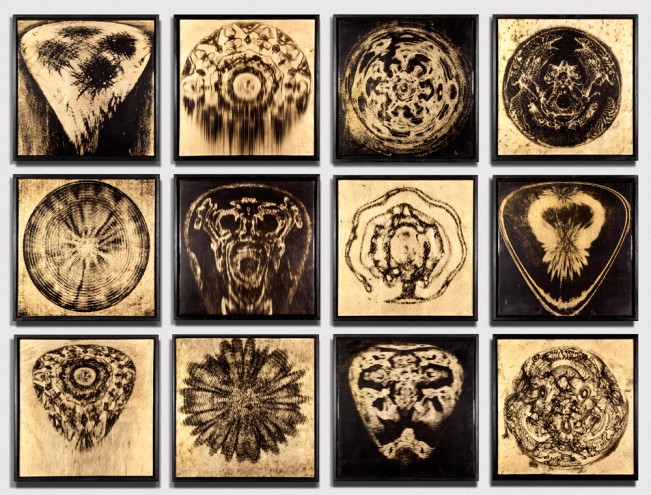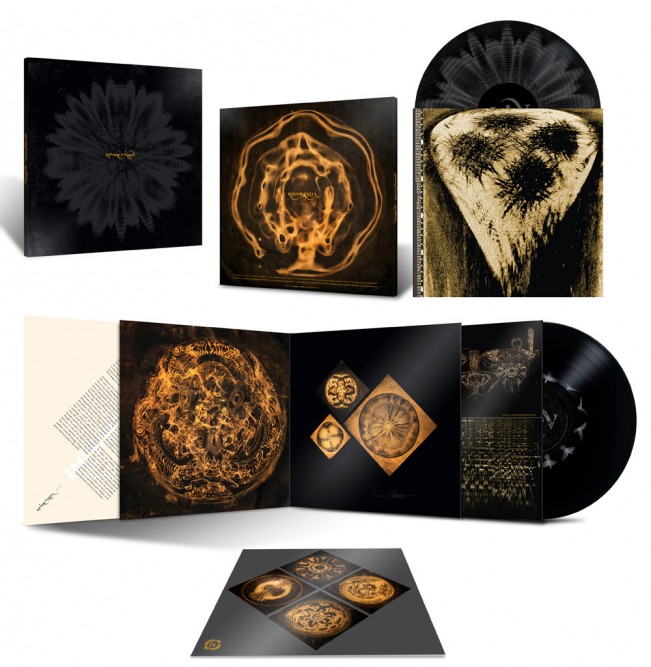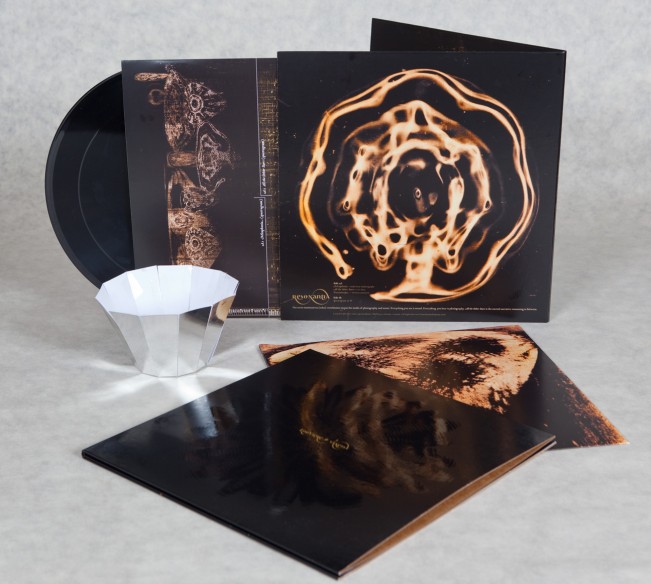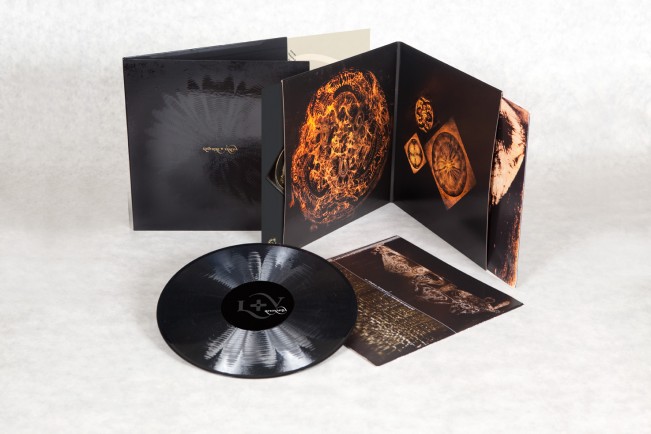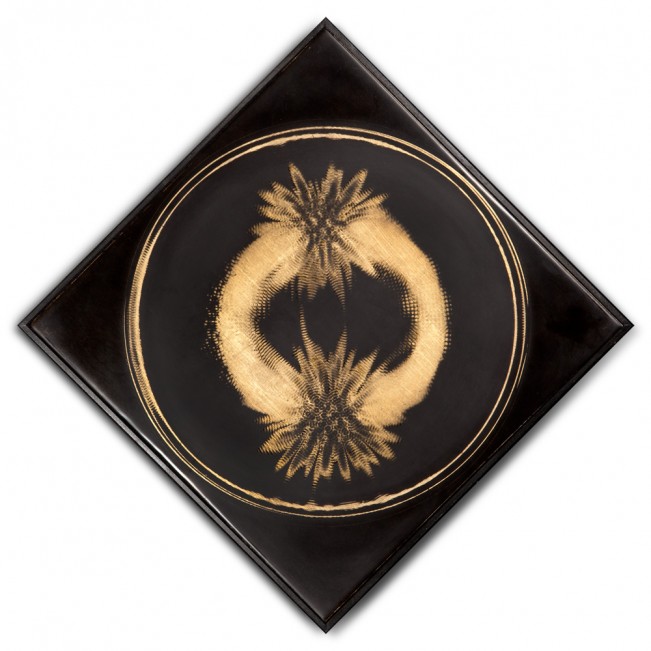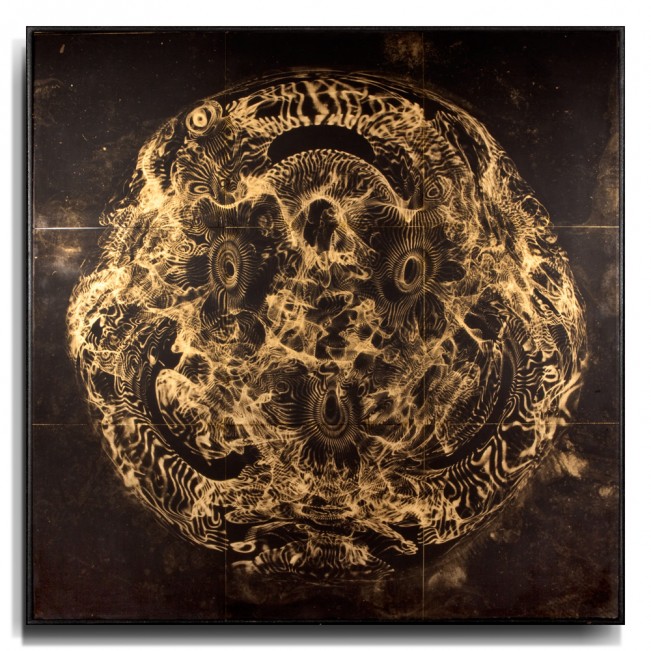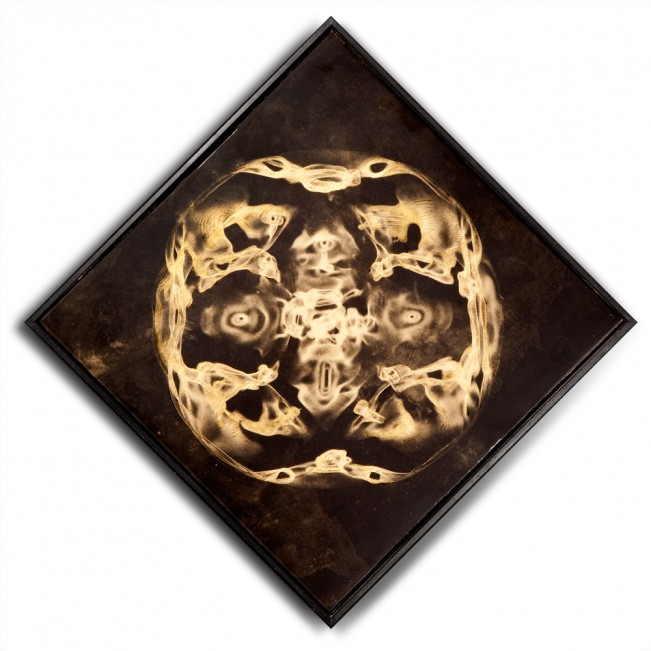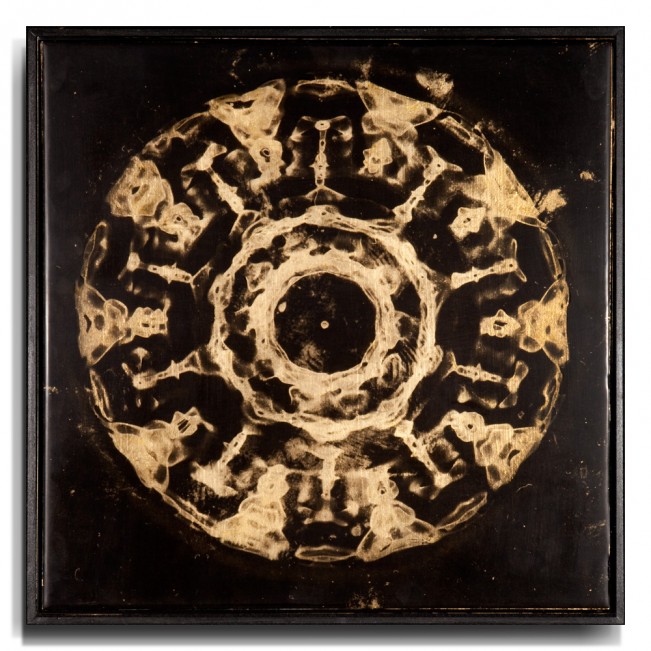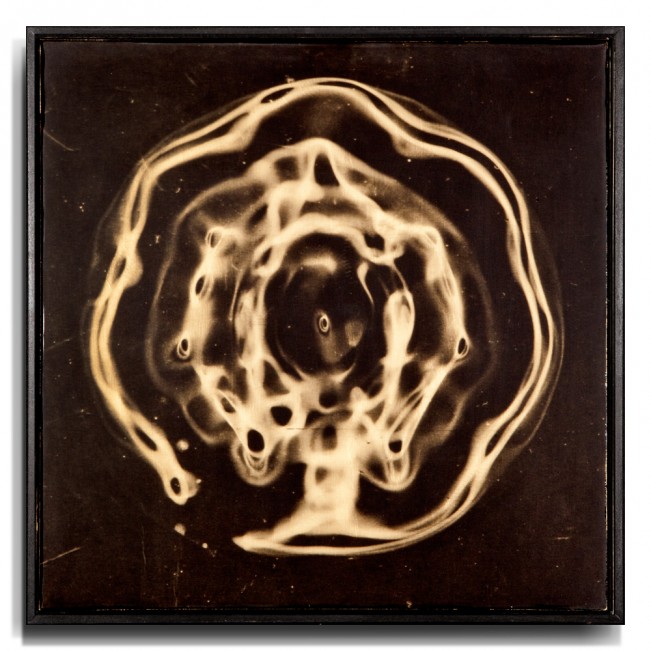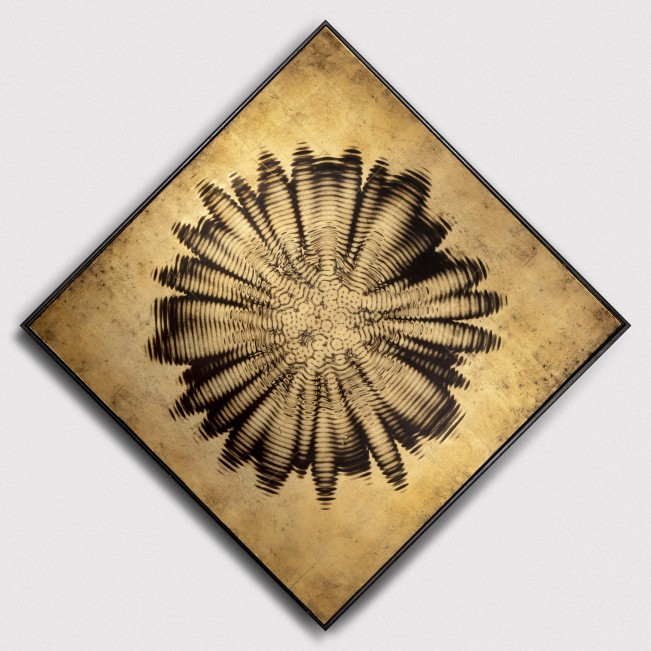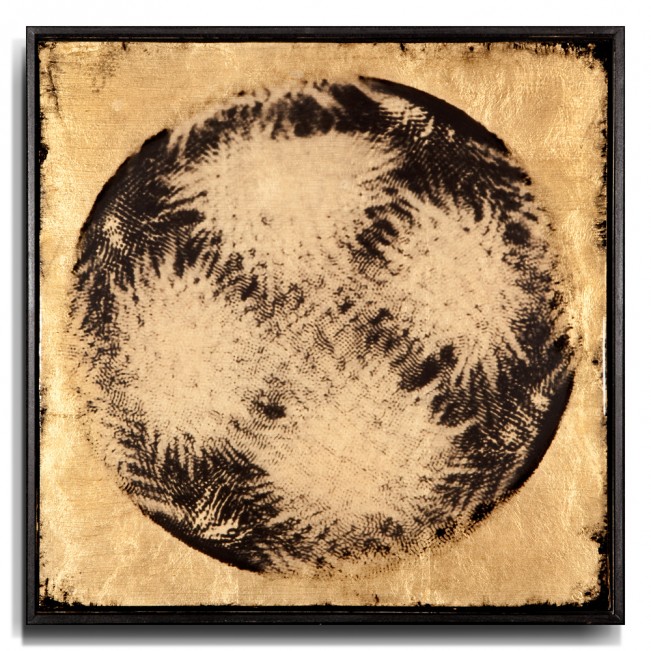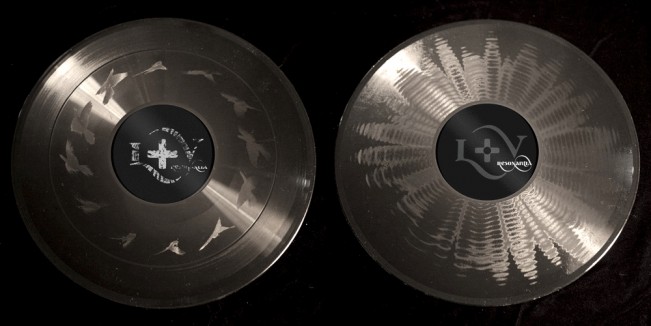Interview with louviere + vanessa: resonantia
Jeff Louviere and Vanessa Brown, otherwise known as Louviere + Vanessa, have produced another groundbreaking and mind-blowing project, Resonantia which will open as an exhibition at the Candela Gallery in Virginia on September 4th (with a reception) and run through October 24th, 2015. This project takes their artistry into new terrains, where they have combined sound and imagery into an album of artwork and sound with a symbiotic relationship of connectedness. We are not only featuring the imagery created from sound but the “music” that creates the imagery. The recordings were produced by Saint Roch Recordings in New Orleans.
An interview with the artists follows. You can listen to a selection of songs at the end of the post.
Resonantia (echo) reverberates across the media of photography and music. Everything you see is sound. Everything you hear is photography. All the Other Stars is the surreal narrative resonating in between. This unique approach to an artist’s exhibition catalog is also a stand alone piece of the exhibition. This album contains all 12 musical notes found using infinite frequencies. A tone generator was used to visualize the images. The photographs were converted back into audio using the image’s grayscale plus the X and Y coordinates. The 12 audio tracks were then mixed to create an ambient soundscape. The images can be re-visualized with the use of a spectrometer. The second song is a Southern Gothic styled duet by L+V accompanied by a 12 frame animation when viewed with the praxinoscope mirror included in the album. The imagery on both sides of the vinyl is mastered directly into the lacquer from sound files. The files were translated from a photograph and carved into the wax using the same tools used to inscribe the grooves of a song.
Four hundred editioned copies have been pressed on super heavy 200-gram vinyl and the whole package is sealed in Library of Congress approved archival polyester bags.
There are 12 special copies pulled from the 400, each representing one of the 12 images. Each of these 12 copies comes with one photograph from the exhibition created exclusively for the album. The edition numbers relate to the frequencies of the photos. The photo is printed on 11″ x 11″ handmade kozo paper and flooded with a wax and damar varnish mixture creating an archival, translucent image. It is then backed in gold leaf and sealed with an archival varnish. Each piece is a one of a kind print that will not be made like this again. Also included in the 12 SE album are the hand written lyrics by L+V and a certificate of authenticity. Each signed and dated.
Statement for Resonantia
Echoes
This new body of work is based on the interaction of sight and sound. Although scientifically categorized as respective senses, they can often work in unison. The term kymatik was coined by the Swiss doctor Hans Jenny in 1967 through his study of visual sound patterns. But this phenomenon had been noted hundreds of years earlier by both Da Vinci and Galileo. Our years of exploring the fringes of photography have driven us to an equal preoccupation with the ways that the gap between sight and sound can be bridged and presented as fine art. Just as a sound can be seen, so too can an image be heard. These images are echoes.
A Vibration Between Mediums
Everything you see is a sound. Everything you hear is a photograph. The photographs, vinyl records, and films are reflections of each other that fluctuate between differing mediums: sight, sound, time, and space. The 12 photographs that represent the 12 notes used to create music. We photographed the sounds using a handmade spectrograph. This led us to wonder about how visuals sound. We transformed the photograph back into a sound and created a three-minute soundscape using all 12 photo-tones. We came full circle by broadcasting that song through a digital spectrometer, which photographed the sound as a spectrogram to revealing all 12 images as a whole.
The 13th Note
This album is an individual work of art. The first track is a 12-note soundscape which can be reconstituted by the listener into photographs by way of a simple spectrometer. The second song is a more traditional duet that pays homage to the muse of art, and it’s a musical version of our Southern Gothic artistic style. It is a visceral response to the technological aspect of the project. The album includes a praxinoscope cut into side A, an analog music video for the duet that turns 12 photographs into a single animation. Side B has a high-resolution gray scale photograph mastered directly into the original lacquer. Its existence as a photograph is accomplished through the time-based process of lacquer mastering for music.
12 Notes, 26 Letters, 10 Numbers — ∞
We believe that the standard dogma—everything has been done before—is false. Despite finite colors, sounds, subjects and material, an artist’s curiosity and delight creates the fathomless. Science and art share the same fascination with the infinite and seek to describe it with the finite. Science finds the infinite in the Idea and art in the perceptible material we use to etch it. It can be as mind-blowing as a snowflake and as sublime as the big bang, each a souvenir of the infinite.
First of all…a big wow. You are charting some new ground here, and it’s more than fascinating. How did the series come about?
A few years ago in Los Angeles, I was with friends from the band The Dagons, and we were talking about shooting a music video with non-Newtonian fluids. When I got home, I told Vanessa about it and started researching the history and technique of recording vibrations. Turns out Galileo and Da Vinci had both been playing with this idea which found a name (kymatik) by a Swiss doctor named Hans Jenny in 1967.
Is this work connected to anything in your earlier explorations, or is this breaking totally new ground for you?
This series was another “what if…” exploration. It relates to our previous work, Folie à Deux which went up the slide the wrong way so to speak. Instead of going from photographer to filmmaker we created films that became photographs. It played with the experience of time-based imagery and space-based imagery. It is breaking new ground for us. In Resonantia, we explored crossing boundaries of senses and mediums by creating a holistic experience.
Do either of you have musical backgrounds?
Involuntary childhood piano lessons don’t really count as musical background! I did sing in chorus through high school, though. The duet Jeff and I did for this will be my debut–unless you count singing to the dogs during their dinner time. Jeff has a long musical background and has been in bands playing guitar since high school. When he’s not playing live, he’s writing and producing his own music, constantly.
It’s a heady idea that sound can be captured as imagery and imagery can be played back as sound. What are a tone generator and a praxinoscope mirror? How did you come to be familiar with these tools?
It is a pretty cool notion, but ultimately apparent since everything has some form of vibration and vibrations affect mediums. We just learned of a team of researchers that are capturing dolphins’ echolocation sounds as sono-pictorial images and communicating with them in their own language. The images they capture that the dolphins emit looks exactly like our photos. In essence, dolphins can see with sound. We wonder what our photos would say to a dolphin!
Almost anything can be a tone generator: drums, a guitar, a dolphin, vocal cords, an earthquake, a comet… but, a textbook tone generator is mainly used for electronic audio acoustics and equipment testing. It’s a machine that can dial in pure, precise frequencies.
The praxinoscope was a precursor to the nickelodeon. The Frenchman, Emile Reynaud patented it in 1877. It’s a series of drawings in a circle with a faceted mirror that when spun created a cyclical animation. In the 1950’s a record company made children’s vinyl records with the center labels as animation. We took the idea and had part of our music video mastered into the dead wax of side A and designed a custom mirrored sheet that people have to cut out and assemble to watch the movie.
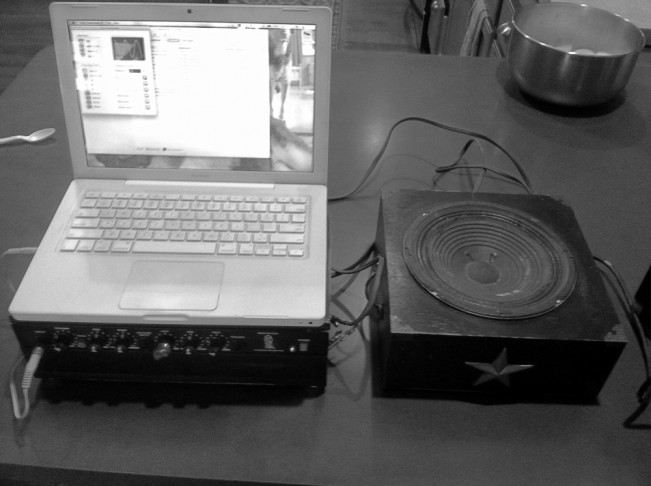 “Science and art share the same fascination with the infinite and seek to describe it with the finite. Science finds the infinite in the Idea and art in the perceptible material we use to etch it.” Continuing this train of thought, the possibility of making the finite infinite, as it relates to photography, might only be possible through the creation of something unseen, but still perceptible. And that perception in some ways has to be more expansive than something visual. Sound is one approach—have you considered other possibilities?
“Science and art share the same fascination with the infinite and seek to describe it with the finite. Science finds the infinite in the Idea and art in the perceptible material we use to etch it.” Continuing this train of thought, the possibility of making the finite infinite, as it relates to photography, might only be possible through the creation of something unseen, but still perceptible. And that perception in some ways has to be more expansive than something visual. Sound is one approach—have you considered other possibilities?
Only half joking here, but the olfactory sense is a human’s strongest sense. It’s the only sense that uses neurons exposed to air, and they link directly to our limbic system controlling emotions like fear and pleasure, as well as drives like hunger, sex and dominance. The act of smelling is almost like thinking. The brain can bring up imagery and experiences through smell so much faster than with sight or sound. What if we could project images into people with just smell? Creepy.
Will you have a performance during the exhibition?
Not at this first show. It’s too much to get the band that far out of town. Next one, though…
As two unique visionaries, do you think working as a collaborative team has affected the outcome of your projects? Do you ever disagree or are you both bringing ideas to the table and pushing each other’s imaginations?
Working as a collaborative team has utterly changed the outcome of our projects as well as our approach to projects. They way the Dadaists used “exquisite corpse” games to give up some control and create a more unfettered route of conception to completion, we have to let some control go to each other. It’s like being on the same page, but one of us is reading the book upside down.
How has this work changed your image making?
Again, control. Working collaboratively we’ve had to have some pretty tight ideas on imagery. Things were sketched out, researched, props made, etc. But with two sources of inspiration we had to let things go in terms of the final image. With this series, we had almost no control on the images themselves. We knew we would get images but dialing in frequencies for 12 notes across an unlimited spectrum was a gamble, and ultimately the sound truly created the final visual subject. We just set the stage.
By not limiting yourselves in respect to your materials, your interests, and the way you define your practice, you have the ability to be open to everything and anything. We need more artists like you, pushing the boundaries of what is possible. That said, thoughts on what might be next on your playlist?
We have years worth of notebook ideas. There’s some stuff with lots of fire. Also, we’re getting into making photographs move. We’ve got a series mixing 19th-century occultist spirit photos with 1950’s absurdist plays like Eugène Ionescu, and some old Alfred Jarry works dealing in ‘pataphysics. There’s a one act play we wrote that will serve as the artist statement. We’ll probably do a soundtrack too.
And finally, describe your perfect day?
First, it can’t be August in New Orleans! A perfect day is late fall, all windows are open for the crisp air to wake us, and two cups of strong hot coffee warm their way down. After a long off-leash “squirrel hunt” at the abandoned golf course with the shepherds we head back to the studio. Then it’s either some rock playlist or a new vinyl record that starts playing while we dig through props, cameras, waxes and paints and start playing too. More often than not, there’s some form of meat marinating or brining or slow cooking that we finally get to dig into at the end of the day with some homemade margaritas and usually a friend or three.
The series Resonantia comes from the Latin word for echo. This work reverberates between the mediums of photography and music.
This album contains all 12 musical notes found using infinite frequencies. A tone generator was used to visualize the images. The photographs were converted back into audio using the image’s grayscale plus the X and Y coordinates. The 12 audio tracks were then mixed to create an ambient soundscape. The images can be re-visualized with the use of a spectrometer.
The second song is a Southern Gothic duet by L+V accompanied by a 12 frame etching in the dead wax that produces an animation with viewed with the praxinoscope mirror included in the album.
The imagery on side B of the vinyl is mastered directly into the lacquer as a high-resolution grayscale photo carved using the same tools used to inscribe the grooves of sound.
Listen to track 1: Misophonia
Listen to track 2: All the Other Stars
Louviere + Vanessa’s work effectively combines the mediums and nuances of film, photography, painting and printmaking. Since they began professionally showing in 2004, they have been in over 50 exhibits and film festivals in America and abroad. They are included in the collections of the Museum of Art | Houston, the Photomedia Center, the New Orleans Museum of Art, the Ogden Museum of Southern Art as well as the film archive for Globians International Film in Potsdam Germany and Microcinema in San Francisco. Six images from the Creature series were acquired by the George Eastman House for an exhibit that traveled the world through 2010. They experiment with moving pictures and have created the first movie shot with a plastic Holga camera consisting of 1,944 frames. L+V were invited to exhibit at the Ballarat Photography Biennale. They had their first solo museum exhibition at the Ogden Museum of Southern Art in October 2012, followed by a solo show at the Polk Museum of Art in Lakeland, FL.
Jeff Louviere is from New Orleans, Vanessa is from New York, and they met each other in Savannah, Georgia. Jeff graduated from the Savannah College of Art and Design during which he and 3 other artists created the world’s largest painting, a 76,000 square foot image of Elvis which was included in the Guinness Book of World Records. Vanessa began photographing at age 12 and won a Kodak International Award of Excellence in Photography when she was 17. She almost became a pro race car driver but instead, she photographed through Italy and Greece before graduating from Rochester Institute of Technology with a degree in Photography.
Louviere + Vanessa’s tableaux vivant series, Slumberland, began in 2003. It is a collection of separate narratives existing as dialogue between the couple. In 2005, they started on their Creature series, a singular story told through many faces and as such the opposite of the Slumberland series. They have a long fascination with themes of duality, and paradox: beauty as horror, creation as destruction, the personal as a universal. Craft and concept are the devices they use to explore the gray zone within those themes.
Posts on Lenscratch may not be reproduced without the permission of the Lenscratch staff and the photographer.
Recommended
-
Tara Sellios: Ask Now the BeastsApril 6th, 2024
-
ALEXIS MARTINO: The Collapsing Panorama April 4th, 2024
-
Emilio Rojas: On Gloria Anzaldúa’s Borderlands: The New MestizaMarch 30th, 2024
-
Artists of Türkiye: Eren SulamaciMarch 27th, 2024
-
Love and Loss in the Cosmos: Valeria Sestua In Conversation with Vicente IsaíasMarch 19th, 2024

